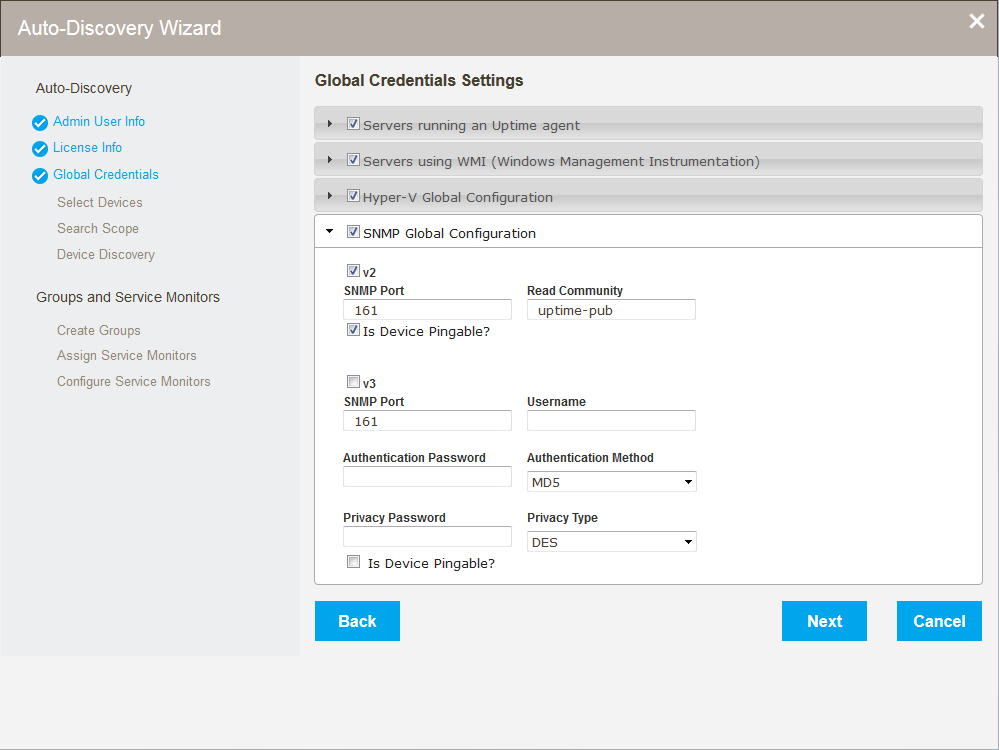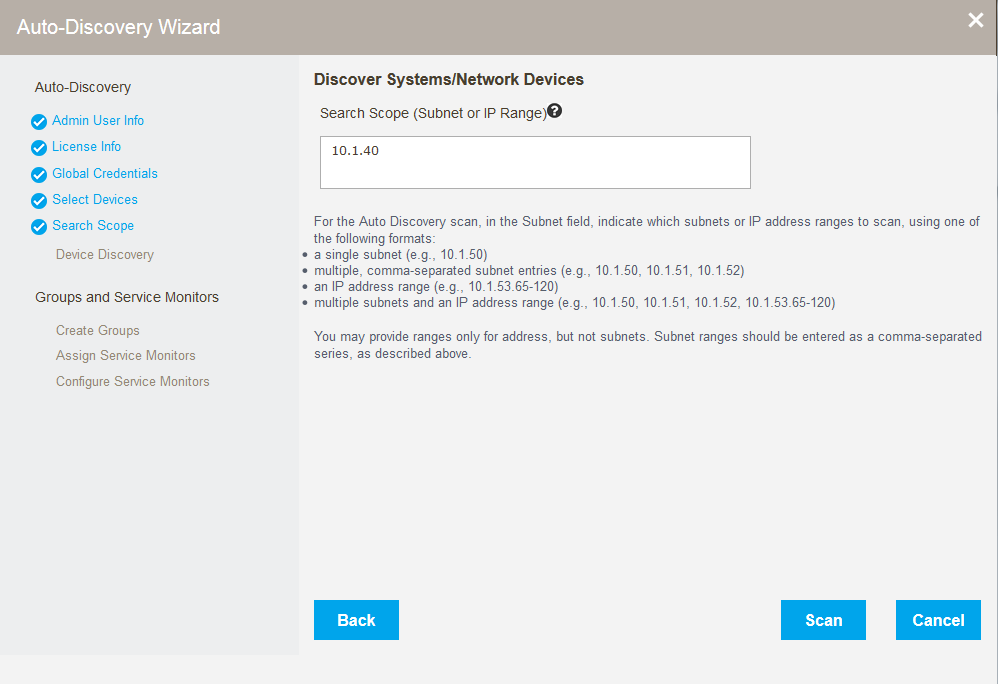...
- Servers running an Uptime Agent
- Servers using WMI (Windows Management Instrumentation)
- Hyper-V Global Configuration
- SNMP Global Configuration (v2 and v3)
Select device types for discovery
The Auto-Discovery Wizard Select Devices to Discover page lets users set options to filter the types of devices discovered when the wizard runs. All of the following device types can be discovered and added in a single pass of the Auto-Discovery Wizard:
- Uptime agents
- WMI agentless
- Microsoft Hyper-V
- Network devices
- Devices using Net-SNMP
- VMware
- IBM pSeries LPAR servers (HMC)
Note that when you choose an option, additional configuration options appear.
Auto Discovery for Servers and Network Devices
...
- the
pingutility is used to determine whether systems are available on the network - a virtual server check is performed first so they are not "blocked" when they are found otherwise
- an Agent check is performed to determine which systems have the Uptime Infrastructure Monitor Agent installed on them
- a WMI check is used to determine whether Windows-based systems are using WMI to gather performance metrics
- SNMP-based network devices are detected
- an SNMP probe is done to find any systems that are using Net-SNMP
Systems that are repeatedly discovered with different checks (e.g., both an Uptime Infrastructure Monitor Agent and WMI implementation are detected on the same system) are by default assigned a type based on the first check that resulted in its discovery. The auto-discovery order is as follows: agent virtual server check, WMI check, Agent check, network device discovery, Net-SNMP probe.
...
- Is Device Pingable? (appears only when using the Network Device option)
Check this box if you can use a ping to verify the status of this device.
Auto Discovery for VMware vCenter and Hyper-V Inventories
A VMware vCenter server acts as a central control point for a VMware vSphere datacenter while a Hyper-V server. It includes ESX hosts, VMs, as well as groupings such as clusters, datacenters, vApps, and resource pools. A VMware vCenter server's inventory, system configurations, storage profiles, and performance data can be represented in Uptime Infrastructure Monitor alongside physical systems and network devices. When a VMware vCenter is added, all of its resources are detected and can be automatically imported.
Microsoft Hyper-V
Provide Microsoft Hyper-V connection information to allow Auto Discovery to import its resources. Select the Use Hyper-V Global Configuration check box if this information is configured (see Configuring Global Data Collection Methods for more information). Be sure to select locations in the Group for hosts and Group for guests fields where you want the newly-discovered data placed.
- Group for hosts
The group into which you want newly-discovered host data placed. - Group for guests
The group(s) into which you want newly-discovered guest data placed. - Collect Uptime Agent data
Select this check box to enable additional monitoring for VMs that are using the Uptime Infrastructure Monitor Agent. - Collect WMI Agentless data
Select this check box if you are using data collection via WMI to enable additional monitoring for VMs that are using WMI.
VMware
Provide VMware vCenter connection information to allow Auto Discovery to import its resources by completing the appropriate options:
- Web Services Port
Accept or modify the default port through which Uptime Infrastructure Monitor connects to the server. - Username and Password
Login credentials for the VMware vCenter administrator. - Group, Virtual Machines Group, and ESX Hosts Group
The group into which you want newly-discovered data is placedplaced. Note that all vCenters must go into the same group. Groups first must be created as only the default groups are available when the Auto-Discovery wizard is initially run.
IBM pSeries LPAR Server (HMC)
...
| Info |
|---|
You may provide ranges only for address, but not subnets. Subnet ranges should be entered as a comma-separated series, as described above. |
Using discovered devices
...
- create groups
- add Service Monitors
- configure Service Monitors
Create groups
...
- Any servers added:
- MySQL Checks
- MySQL Basic Checks (runs a query to test query engine)
- MySQL Advanced Checks (pulls performance information from the DB engine)
- MySQL Checks
...



